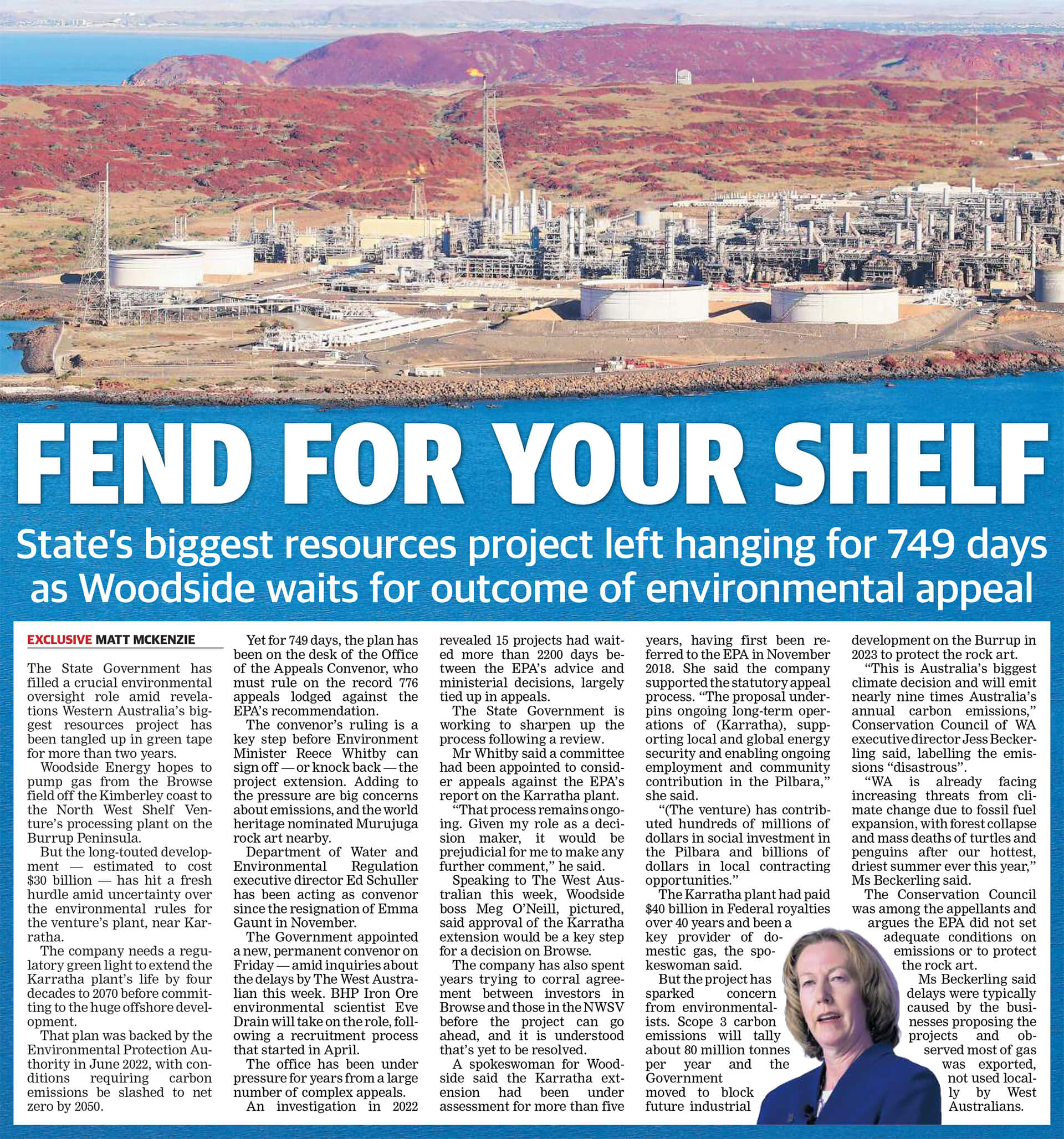
Article by Matt Mckenzie, courtesy of The West Australian.
The State Government has filled a crucial environmental oversight role amid revelations Western Australia’s biggest resources project has been tangled up in green tape for more than two years.
Woodside Energy hopes to pump gas from the Browse field off the Kimberley coast to the North West Shelf Venture’s processing plant on the Burrup Peninsula.
But the long-touted development — estimated to cost $30 billion — has hit a fresh hurdle amid uncertainty over the environmental rules for the venture’s plant, near Karratha.
The company needs a regulatory green light to extend the Karratha plant’s life by four decades to 2070 before committing to the huge offshore development.
That plan was backed by the Environmental Protection Authority in June 2022, with conditions requiring carbon emissions be slashed to net zero by 2050.
Yet for 749 days, the plan has been on the desk of the Office of the Appeals Convenor, who must rule on the record 776 appeals lodged against the EPA’s recommendation.
The convenor’s ruling is a key step before Environment Minister Reece Whitby can sign off — or knock back — the project extension. Adding to the pressure are big concerns about emissions, and the world heritage nominated Murujuga rock art nearby.
Department of Water and Environmental Regulation executive director Ed Schuller has been acting as convenor since the resignation of Emma Gaunt in November.
The Government appointed a new, permanent convenor on Friday — amid inquiries about the delays by The West Australian this week. BHP Iron Ore environmental scientist Eve Drain will take on the role, following a recruitment process that started in April.
The office has been under pressure for years from a large number of complex appeals.
An investigation in 2022 revealed 15 projects had waited more than 2200 days between the EPA’s advice and ministerial decisions, largely tied up in appeals.
The State Government is working to sharpen up the process following a review.
Mr Whitby said a committee had been appointed to consider appeals against the EPA’s report on the Karratha plant.
“That process remains ongoing. Given my role as a decision maker, it would be prejudicial for me to make any further comment,” he said.
Speaking to The West Australian this week, Woodside boss Meg O’Neill, pictured, said approval of the Karratha extension would be a key step for a decision on Browse.
The company has also spent years trying to corral agreement between investors in Browse and those in the NWSV before the project can go ahead, and it is understood that’s yet to be resolved.
A spokeswoman for Woodside said the Karratha extension had been under assessment for more than five years, having first been referred to the EPA in November 2018. She said the company supported the statutory appeal process. “The proposal underpins ongoing long-term operations of (Karratha), supporting local and global energy security and enabling ongoing employment and community contribution in the Pilbara,” she said.
“(The venture) has contributed hundreds of millions of dollars in social investment in the Pilbara and billions of dollars in local contracting opportunities.”
The Karratha plant had paid $40 billion in Federal royalties over 40 years and been a key provider of domestic gas, the spokeswoman said.
But the project has sparked concern from environmentalists. Scope 3 carbon emissions will tally about 80 million tonnes per year and the Government moved to block future industrial development on the Burrup in 2023 to protect the rock art.
“This is Australia’s biggest climate decision and will emit nearly nine times Australia’s annual carbon emissions,” Conservation Council of WA executive director Jess Beckerling said, labelling the emissions “disastrous”.
“WA is already facing increasing threats from climate change due to fossil fuel expansion, with forest collapse and mass deaths of turtles and penguins after our hottest, driest summer ever this year,” Ms Beckerling said.
The Conservation Council was among the appellants and argues the EPA did not set adequate conditions on emissions or to protect the rock art.
Ms Beckerling said delays were typically caused by the businesses proposing the projects and observed most of gas was exported, not used locally by West Australians.
